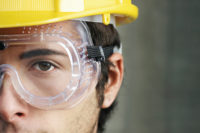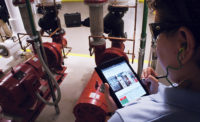Facility safety
The risk engineering approach includes the following steps:1. Define the facility and environments. Include functions, purpose of the facility and equipment, uses, foreseeable misuses, all environments in which it will operate, and the life-cycle phases of interest.
2. Identify the hazards. Identify hazards that could exist as a result of normal use, foreseeable misuse or malfunction of the facility or equipment. Consider all life-cycle phases identified in the facility definition.
3. Evaluate the risk. After specific hazards are identified, determine the likelihood of a mishap occurring and the severity of injury or damage that could result if any of the hazards were to propagate a mishap.
4. Develop corrective actions and/or safety design criteria. Determine if the severity or likelihood of a mishap occurring can be eliminated or reduced by redesign, redundant systems, fail-safe design, guarding, instructions or warnings.
5. Verify acceptability of risk. Verify through test, sampling, or analysis that the hazards have been controlled to an acceptable level.
Different techniques
A number of different techniques are used. The preliminary hazard analysis, failure modes and effects analysis, operational hazard analysis, and fault tree analysis are used to identify the hazards associated with the workplace, the way accidents can occur, and to develop safeguards to reduce risk.Risk engineering techniques provide a method for early introduction of occupational health concerns. They generate requirements for purchasing safe products, developing safe operating procedures, environmental control, and industrial hygiene monitoring programs.
A preliminary hazard analysis of the workplace finds the major safety concerns. Possible equipment failures and human errors are anticipated. Ways to reduce the chances and the consequences of failure are identified.
Failure modes and effects analysis (FMEA) can be used to assess each type of failure associated with equipment in the factory. Critical components of the equipment are assessed for their potential failure modes and their possible effects. Safety requirements for equipment safety can be added to the company’s purchase orders.
Fault tree analysis is used to evaluate how human error, equipment failure and the environment can cause a workplace accident.
Job safety analysis and the operating hazards analysis can be used to review a work activity for potential hazards. The job is broken down into its individual actions and each activity is described in detail. The potential hazards of each element of the task are listed with ways to eliminate or reduce the effects of the hazard. Industrial hygiene techniques of sampling and classifying environmental hazards are important input to the hazard analysis.
Operator involvement
The skills and capabilities of the operator of the equipment must be understood. The operator’s expectations of how equipment operates must be determined. The operator must have the skill to understand the instructional material that comes with new equipment or the company must create appropriate training courses and materials. Human factors engineering principles must be applied to reduce the probability of unsafe operation. Special training may be required to assure safe and effective operation of the machine.Identification of hazards is essential to their prevention and control. The earlier the hazards are recognized, the easier it is to make changes. After the risks are known, the question becomes one of countermeasures to reduce the risk. The first effort to reduce workplace risk can be made by the choice of equipment and the design of the workstation. The workplace can be modified to reduce or eliminate the hazard. When possible, it is always preferable to reduce risks by altering the design of the workplace or selecting safer equipment and materials. After the choice of equipment and materials is made, hazardous parts, energy sources, or materials can be isolated from human contact by the addition of interlocks, guards and other protective equipment.
When it is impractical to isolate a hazard completely, it is usually possible to have people subject to the danger wear protective equipment. Personal protective equipment can include eye protection, ear protection, respirators and filters, and special clothing.
Warnings
Labels and manuals providing special instructions or warnings are an important element of the effort to reduce risk. The risk analysis will determine what warnings are needed, what they should say, and how they should be communicated to the workers. There are companies like Hazard Communication Systems (www.safetylabel.com) that are in the business of preparing cost-effective warnings that meet legal and regulatory requirements. According to company president Geoffrey Peckham, who is also a member of the key United States and international warning standards committees, many of his company’s requests for help come from “companies whose insurance company has advised them to improve their warnings or after the company has had an expensive lawsuit.†Many thousands of dollars can be saved by early risk analysis and the development of effective warnings.
An additional measure of protection can be gained by requiring employees to follow special procedures when they are subject to hazards. This may require special training. Refresher courses may be required to reduce the possibility that they will forget instructions or become complacent.
Fixing what’s broken
Early application of risk analysis can reduce workplace hazards. A risk analysis and liability audit highlights what’s broken and makes recommendations for increasing workplace safety and reducing liability. Ongoing support by a safety lawyer and risk assessment of the workplace, especially before introducing new equipment, can save thousands of dollars in lost production time, medical costs, workers’ compensation claims and insurance premiums.
Editor’s Note: This article was adapted from Lewis Bass’ “Products Liability: Design and Manufacturing Defects, 2nd Edition,†Chapter 15, published by the West Group, www.westgroup.com.
SIDEBAR: How the safety lawyer fits in
A safety lawyer can add an important dimension to the risk analysis team. The safety lawyer has experience with OSHA investigations and workers’ compensation claims. With the safety lawyer’s experience, he can make suggestions to increase worker safety and decrease regulatory and liability risks.A company can also be sued by construction contractors, equipment service personnel and other non-employees. A safety lawyer can determine how effectively the company can defend these types of lawsuits. He can point out any gaps in the workplace safety program.

